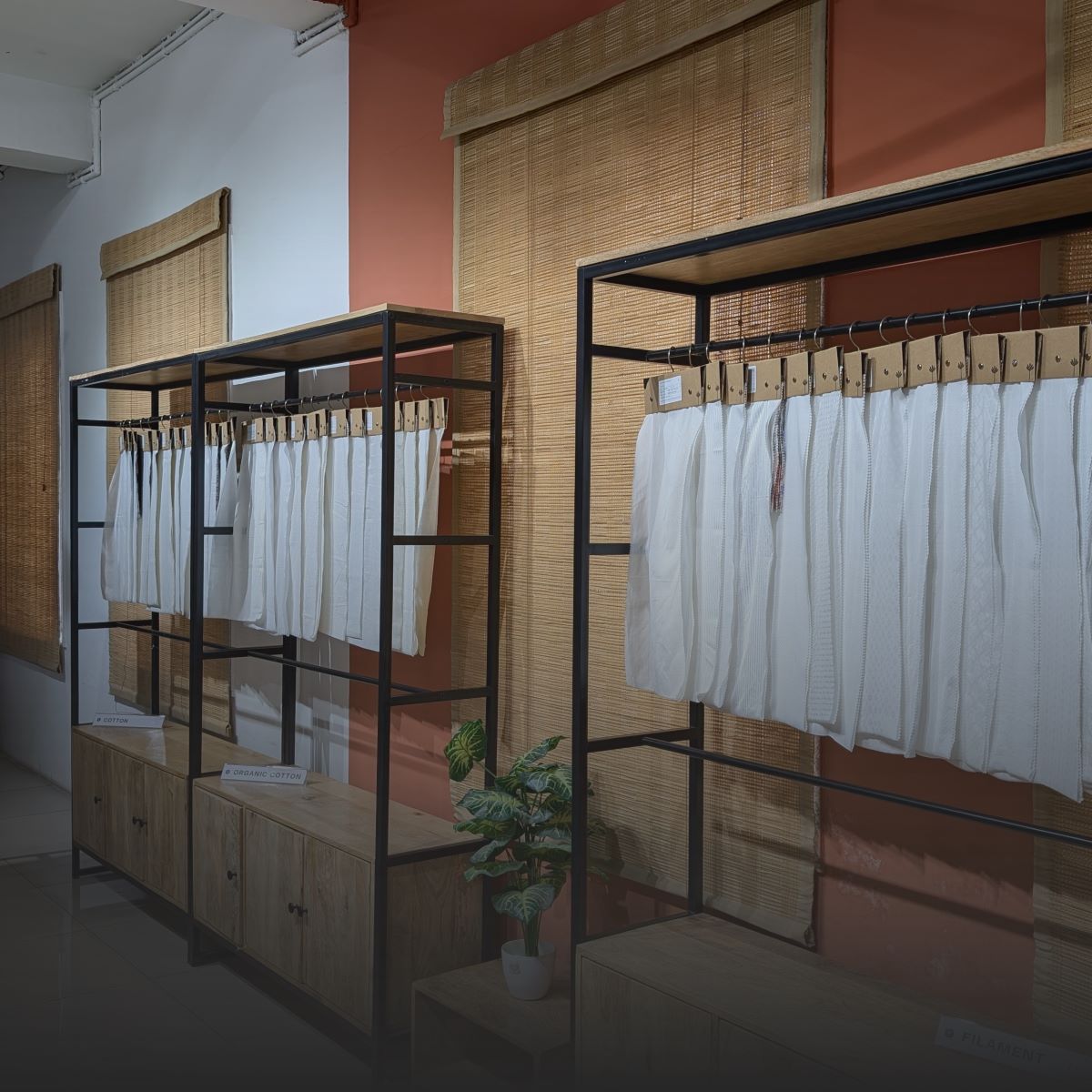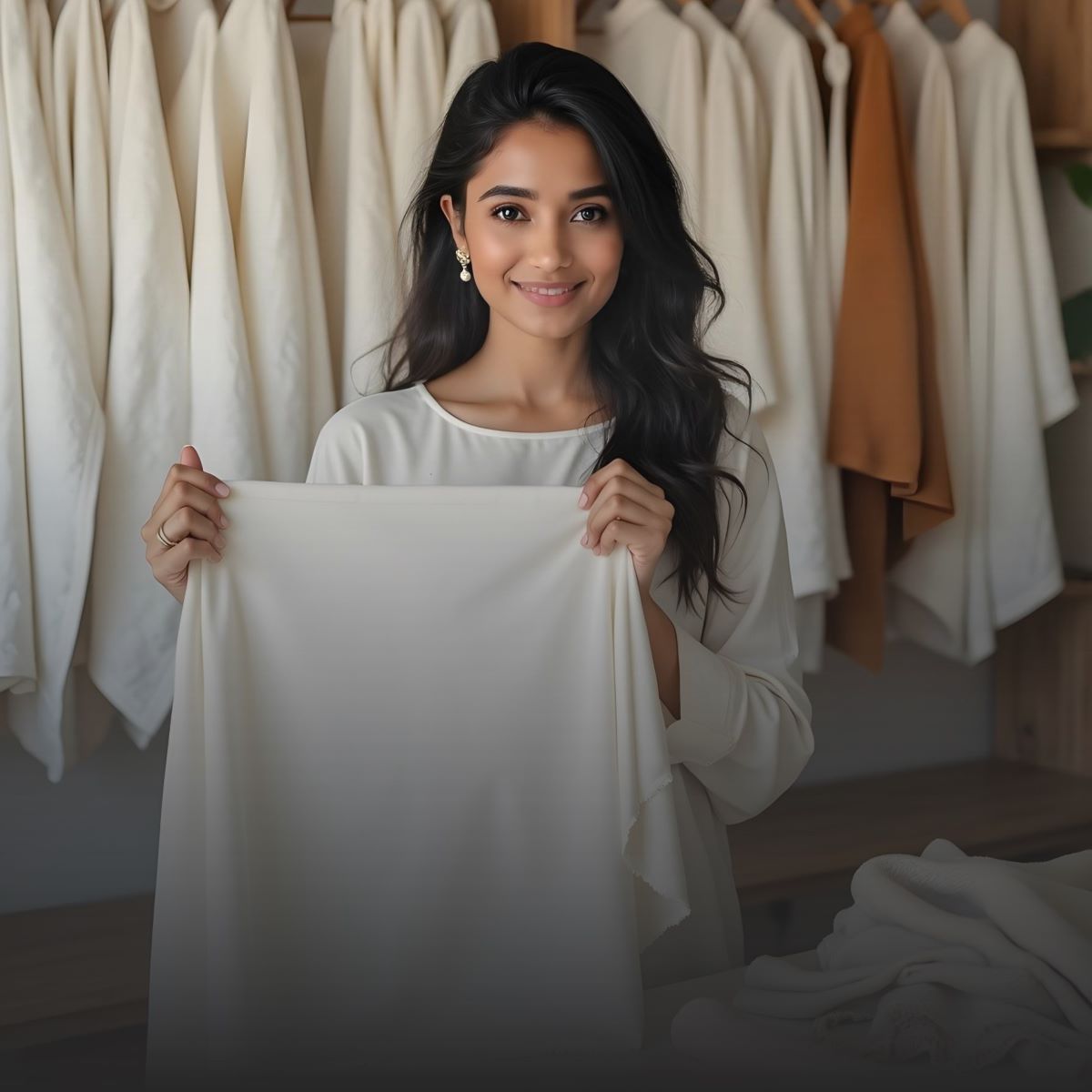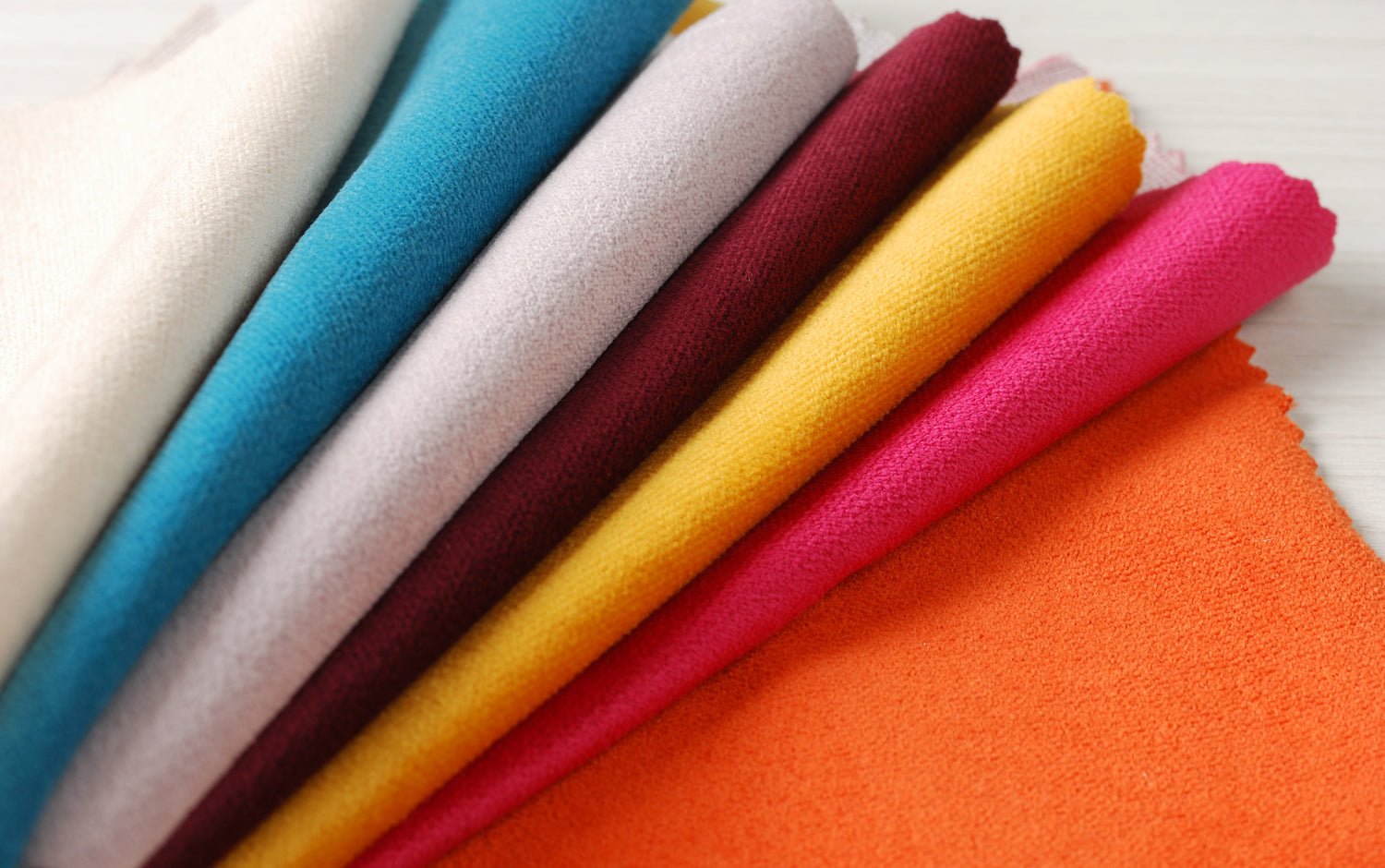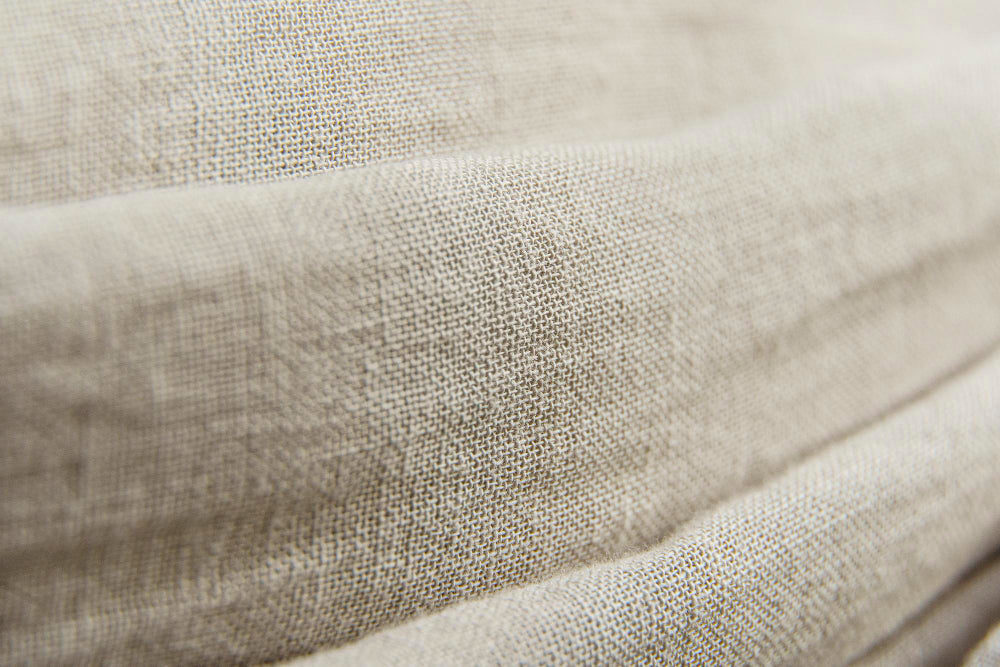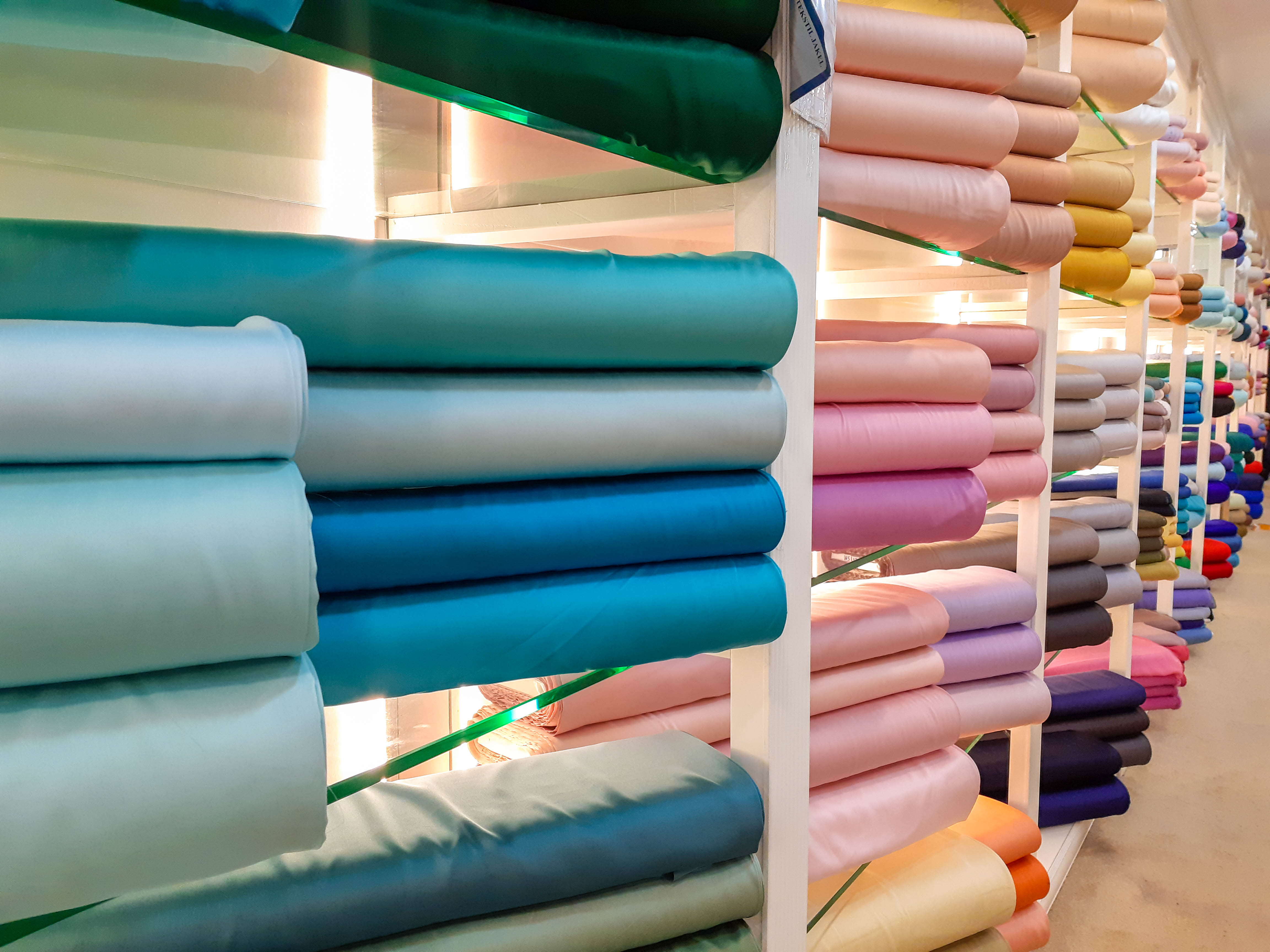Every great fashion collection starts with finding the right fabric for shirts and dresses. The right textile choice determines how your clothes feel, drape, and perform, whether you're a global boutique, a small fashion brand, or a private label designer.
Fabriclore helps you turn your design ideas into real fabrics. We offer export-ready clothing manufacturers and fabric suppliers from India 100+ mill-dyed solids, 30+ yarn-dyed options, and 5000+ colour combinations, such as sustainable blends like LivaTM, LENZINGTM, BembergTM, Cupro, and Organic Cotton. We make it easier for foreign brands that want accuracy, variety, and dependability to source from us by offering low MOQs, 15-day global shipping, and certified quality.
Let's talk about the best fabrics for dresses and shirts, and how to choose the right ones for your following collection.
Understanding the Query: Suitable Fabric for Shirts and Dresses
A lot of the time, designers and buying teams ask,
Which fabric is most suitable for shirts and dresses?
The answer depends on multiple factors — fiber type, weave, GSM, season, and the overall look you're aiming for. Shirts need structure and breathability, while dresses require drape, softness, and movement.
At Fabriclore, we offer both natural and regenerated fabrics that balance comfort with style — ideal for everything from bright office shirts and casual cotton dresses to luxury silk creations and eco-resort wear.
Understanding Fabric Categories: What Makes a Fabric 'Suitable'?
Each apparel fabric belongs to a group based on its origin and manufacturing method. Buyers can better match fabrics to the right products when they know about these groups.
|
Category |
Source |
Ideal Use |
Key Benefits |
|
Natural Fabrics |
Cotton, Linen, Hemp, Silk, Wool |
Everyday wear, breathable garments |
Renewable, biodegradable, soft |
|
Regenerated Cellulosic Fabrics |
Liva™, LENZING™, Bemberg™ Cupro, Modal, Viscose |
Fluid dresses, shirts, sustainable collections |
Eco-friendly, silky, luxurious |
|
Blended Fabrics |
Cotton-Linen, Cotton-Poly, Silk-Viscose |
Versatile wear, co-ords, uniforms |
Balanced comfort and durability |
|
Yarn-Dyed Fabrics |
Chambray, Checks, Denim |
Shirts, dresses, workwear |
Colorfast, strong texture |
|
RFD (Ready for Dye) Fabrics |
Cotton, Linen, Silk |
Custom coloration and branding |
Quick sampling, Pantone matching |
Crisp poplins are used to make stiff shirts, while fluid viscose or LivaTM fabrics are used to make easy-to-wear dresses.

The Best Fabrics for Shirts and Dresses
Picking the correct fabric for shirts and dresses is more than just a style choice; it affects how the item feels, works, and lasts. Every material has its own benefits, from cotton and linen that let air flow through to silk that looks classy and new, and sustainable fibers.
Fabriclore collects a wide variety of high-quality fabrics for sale. All of them are OEKO-TEX® certified, AZO-free processed, and tested for GSM, shrinkage, and color fastness. These fabrics are great for building classic, long-lasting collections, whether you're a boutique brand, a private label, or a global clothing manufacturer.
Fabric Overview Table
|
Fabric |
Composition |
GSM Range |
Best For |
Key Highlights |
|
Cotton |
100% Cotton |
80–180 |
Shirts, shirt dresses, uniforms |
Breathable, easy to dye, AZO-free, versatile |
|
Linen & Blends |
100% Linen / Cotton-Linen |
110–220 |
Resortwear, co-ords, summer shirts |
Textured, moisture-wicking, crisp hand feel |
|
Viscose & Modal |
Regenerated Cellulose |
100–180 |
Dresses, blouses, tunics |
LENZING™ certified, silky drape, vivid color |
|
Silk & Blends |
Pure Silk, Crepe, Chanderi, Organza |
50–120 |
Luxury shirts, occasion dresses |
Lustrous, lightweight, premium finish |
|
Liva™ / LENZING™ / TENCEL™ |
Sustainable Cellulosic Fibers |
90–180 |
Sustainable shirts, eco dresses |
Biodegradable, smooth, breathable |
|
Bemberg™ Cupro |
Cotton Linters |
100–160 |
Premium shirts, linings |
Anti-static, soft sheen, biodegradable |
|
Hemp & Organic Cotton |
Hemp / Organic Cotton |
100–200 |
Sustainable shirts, workwear |
Strong, antibacterial, GOTS certified |
|
Jute & Bamboo Blends |
Jute-Cotton, Bamboo-Cotton |
120–230 |
Workwear, eco fashion |
Textured, breathable, naturally antimicrobial |
More than 20 quality checks are conducted on all fabrics to ensure consistency and compliance with export standards.
Detailed Fabric Guide
Here's more information about each fabric to help you choose the right one for your clothing manufacturing firm. It describes what it's made of, its GSM range, and how well it fits modern clothing styles.
Cotton: The Universal Fabric for Shirts and Dresses
Composition: 100% Cotton
GSM: 80–180
Best For: Shirts, shirt dresses, uniforms
Cotton is still the primary material used to make clothes worldwide. It's great for bulk production in all kinds of weather because it breathes well, is soft, and takes different dyes well. They have pre-dyed solids and RFD (Ready for Dye) poplin, cambric, twill, chambray, and satin weaves.
Highlights:
- Excellent moisture absorption and comfort
- Pantone-matched custom dyeing available
- OEKO-TEX® certified, AZO-free processing
Linen & Linen Blends: Cool, Natural, and Timeless
Composition: 100% Linen / Cotton-Linen
GSM: 110–220
Best For: Resortwear, co-ords, summer shirts
Designers love linen because it has a nice feel and lets air flow through it. It becomes softer and less wrinkled when mixed with cotton, making it perfect for creating shirts and dresses for hot climates.
Highlights:
- Natural slub texture with a crisp structure
- Moisture-wicking and quick-drying
- Available in earthy tones, neutrals, and RFD options
Viscose & Modal: Flow, Comfort, and Color Brilliance
Composition: Regenerated Cellulose (Liva™, LENZING™ Viscose, Modal)
GSM: 100–180
Best For: Fluid dresses, tunics, blouses
These recycled materials have the luxurious feel of silk while still being very breathable. Premium resortwear brands love them because they look great with loose shapes and bright prints.
Highlights:
- Eco-certified by LENZING™
- Smooth, fluid drape ideal for dresses
- Retains color brightness and texture after washes
Silk & Silk Blends: Luxury That Lasts
Composition: Pure Silk, Crepe, Chanderi, Organza
GSM: 50–120
Best For: Luxury shirts, occasion dresses
Silk is still the most elegant fabric available. It looks beautiful, feels light, and drapes beautifully, making it great for high-end brands and couture collections. Fabriclore offers both ready-dyed and RFD versions so that customers can make their own choices.
Highlights:
- Natural sheen and smooth texture
- Breathable and temperature-regulating
- Compatible with acid and reactive dyes

Liva™, LENZING™, and TENCEL™: Sustainable Innovation
Composition: Certified Sustainable Wood Pulp
GSM: 90–180
Best For: Sustainable shirts, eco dresses, co-ords
These new fibres change how comfort and the surrounding environment interact. They are soft like silk and airy like cotton because they are made from renewable forestry. They are great for eco-friendly brands because of this.
Highlights:
- Biodegradable and eco-certified
- Silky texture with excellent dye uniformity
- Preferred for global sustainable fashion lines
Bemberg™ Cupro: The Silk Alternative
Composition: Cupro from Cotton Linters
GSM: 100–160
Best For: Premium shirts, dress linings
Cupro fabric offers a soft handfeel and antistatic properties; it's widely used in high-end fashion and as a lining for luxury garments. BembergTM Cupro is known as the "vegan silk".
Highlights:
- Silky drape with antistatic comfort
- Breathable, biodegradable, and skin-safe
- Excellent color depth and texture retention
Hemp & Organic Cotton: Conscious Fashion Choices
Composition: Hemp / Hemp-Cotton & GOTS Organic Cotton
GSM: 100–200
Best For: Sustainable shirts, workwear, casual dresses
These fibers will be eco-friendly and long-lasting. Hemp is stronger and more UV-resistant, and Organic Cotton is better for your skin and doesn't contain pesticides.
Highlights:
- Naturally antibacterial and durable
- Certified by GOTS & OEKO-TEX®
- Perfect for eco-conscious and traceable sourcing
Jute & Bamboo Blends: Earthy and Enduring
Composition: Jute-Cotton / Bamboo-Cotton Blends
GSM: 120–230
Best For: Workwear, eco fashion, structured shirts
These mixes combine the softness of bamboo with the strength and texture of jute. This creates a balance between comfort and structure that is great for uniforms and collections with a natural theme.
Highlights:
- Distinct earthy texture with breathability
- Naturally antimicrobial and sustainable
- Long-lasting and biodegradable
Why Global Buyers Trust Fabriclore
Fabriclore has 10+ years of experience in fabric sourcing, dying, and printing, which is why foreign brands and private labels trust them to find the right fabrics.
|
Advantage |
Details |
|
Export-Ready Infrastructure |
ISO 9001 & SEDEX certified manufacturing units |
|
Tech-Enabled Sourcing |
Digital swatch sharing, real-time order tracking |
|
Sustainability Commitment |
OEKO-TEX® certified, AZO-free dyes, low-water processing |
|
MOQ Flexibility |
5 meters for sampling, 100 meters per color for bulk |
|
Fast Global Delivery |
10–15 days worldwide through DHL & FedEx |
|
Expert Support |
Dedicated sourcing specialists for fabric development |
Fabriclore gives brands the tools they need to build efficient, ethical, and scalable buying systems.

How to Choose the Right Fabric Based on Garment Type
|
Apparel Type |
Recommended Fabrics |
Ideal GSM |
Attributes |
|
Formal Shirts |
Cotton Poplin, Liva™, Satin |
100–140 |
Crisp, breathable, elegant |
|
Casual Shirts |
Linen, Chambray, Twill |
110–160 |
Soft, textured, relaxed |
|
Women’s Dresses |
Viscose, Modal, Silk |
90–160 |
Flowing, smooth, light |
|
Shirt Dresses |
Cotton-Linen, Chambray |
120–180 |
Light structure, soft drape |
|
Resortwear / Co-ords |
LENZING™, Linen, Organic Cotton |
100–200 |
Airy, sustainable, vibrant |
|
Luxury Wear |
Silk, Cupro |
80–120 |
Premium finish, glossy touch |
Take climate, drape, and end use into account when choosing materials.
Sustainability Focus: Certified Eco-Friendly Fabrics
Global ESG standards and circular fashion goals align with Fabriclore's sustainable fabric line.
|
Fabric Type |
Eco Feature |
Certifications |
|
Liva™ |
Made from renewable wood pulp |
OEKO-TEX®, Livaeco™ |
|
LENZING™ / TENCEL™ |
Closed-loop manufacturing |
FSC®, EU Ecolabel |
|
Bemberg™ Cupro |
Derived from cotton linters |
GRS, OEKO-TEX® |
|
Organic Cotton |
Pesticide-free, fair trade |
GOTS, Fair Trade |
All of the materials are eco-friendly and biodegradable.
Fabric Lifecycle: From Farm to Fashion
Fabriclore makes sure that quality and tracking are maintained at all stages of the production process:
- Sourcing: Certified organic and sustainable fibers
- Weaving: Modern looms ensure consistent GSM and density
- Dyeing: Low-liquor-ratio, AZO-free processes
- Finishing: Enzyme and soft-flow treatments
- Quality Check: 20+ inspection points
- Shipping: Fast, trackable global delivery
This unified method makes sure that all export orders are precise, reliable, and of the same high standard every time.
Common Sourcing Mistakes and How to Avoid Them
|
Mistake |
Impact |
Solution |
|
Skipping GSM & shrinkage testing |
Poor fit or drape |
Verify lab reports before bulk |
|
Ignoring swatch approval |
Shade mismatch |
Request lab dips |
|
Buying uncertified blends |
Sustainability compliance issues |
Confirm OEKO-TEX® or GOTS certification |
|
Not maintaining dye recipes |
Color inconsistency |
Store approved color codes |
|
Overlooking reordering parameters |
Shade variation |
Use Pantone-matched dyeing |
Fabriclore keeps digital copies of all accepted recipes to ensure they remain the same.

Final Thoughts: Fabriclore — Where Craft Meets Technology
The right cloth can turn an idea into a work of art. Fabriclore helps you make clothes that meet today's fashion standards, like cotton shirts that let air flow through, fluid viscose dresses, or eco-luxury lines.
Fabriclore has been sourcing, dying , and printing fabrics for 10 years and offers certified quality, flexible MOQs, and tech-driven transparency, helping brands safely produce products for global markets.
👉 Explore 100+ certified fabrics at Fabriclore.com and design shirts and dresses that embody comfort, conscience, and craftsmanship.
FAQs
1. What Are The Best Fabrics For Shirts And Dresses?
The best fabrics for shirts and dresses are those that are comfortable, let air flow, and look good. Each type is used for a different design goal, like clean cutting, smooth drape, or long-lasting appeal.
- Cotton & Linen: Breathable classics for daily wear
- Viscose & Modal: Smooth drape and vibrant flow
- Silk & Bemberg™: Elegant and luxurious texture
- Organic Cotton & Hemp: Ideal for sustainable collections
Each offers comfort, versatility, and consistent export-grade quality.
2. How Do I Choose The Right Gsm And Weave?
Choosing the right GSM (grams per square meter) and weave will affect how the fabric holds its shape, feels, and changes with the seasons. Lighter fabrics are easier to move in, while heavier ones give shape and character.
- Shirts: 90–160 GSM (Poplin, Cambric, Twill)
- Dresses: 100–180 GSM (Liva™, Viscose, Silk)
- Light GSM: Perfect for warm climates and summer wear
- High GSM: Best for structured, formal silhouettes
Select the correct GSM for the audience and the purpose of the garment.
3. Are These Fabrics Sustainable And Export-Compliant?
Yes, Fabriclore's whole line is approved and made in a way that meets strict standards for sustainability and sale. This makes certain that everyone follows the rules and looks after the area.
- Certified by: OEKO-TEX®, GOTS, SEDEX
- Dyeing Process: AZO-free and low-water consumption
- Ethical Production: Responsible labor and traceable supply chain
Full compliance with social and environmental standards set by the United Nations.
4. What Mistakes Should I Avoid While Sourcing Fabrics?
Sourcing problems can occur even for the most skilled buyers. It is essential to closely monitor testing, certification, and approval processes to ensure consistent standards across all collections.
- Avoid skipping lab dips and GSM testing
- Always check OEKO-TEX® or GOTS certifications
- Maintain approved dye recipes for reorders
- Confirm shrinkage and color fastness before production
By following these steps, you can avoid expensive problems with quality or color.
5. How Quickly Can I Get Samples And Bulk Fabric?
Fabriclore makes buying fast, accurate, and global. From samples to large purchases, every step is fast and accurate.
- The swatches (RFD) were sent out within 24 hours.
- Ready in two to three business days for samples (5m)
- Deliveries for large orders take 10 to 15 days.
- Custom-dyed yarn takes 4 to 6 weeks and is exact to Pantone.
All shipments can be tracked in real time by DHL and FedEx, which gives you complete insight into the supply chain.
We also happen to be a magnet for suggestions, and would love to catch yours….throw us yours on hello@fabriclore.com
Also Read Related blog: How to Choose the Perfect Linen Fabric for Any Party Occasion
